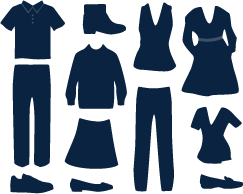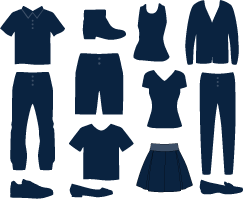What you wear can be a form of self-expression and contributes to the development of your personal brand. The way you dress in professional settings can also provide a signal of your maturity and self-awareness for employers and other professionals.
In this context, professional dress and attire are defined as variations of dress codes appropriate within different professional settings. The chart and guidelines below are available to help you understand what is appropriate for each code of dress.

Business Professional
Required for Professional Headshot Photos, Mock Interviews, Interviews
(unless otherwise indicated by interviewer)
Skirt or pant suit, dress with slip lining
- Recommended suit colors: charcoal, navy, black, or brown
- Skirt suits or dresses should be knee length with a conservative slit
- Professional top in a conservative color, neutrals or pastels are suggested
- Ironed button up shirt and solid or striped conservative color tie
- Minimize accessories and keep jewelry simple
- Carry a purse or professional bag and a pad / portfolio to take notes and neatly hold your materials

Business Casual
Required for Employer-in-Residence Meetings, Employer or Alumni Coffee Chats, Industry Days, Career Fairs
Relaxed business attire
- Collared or polo shirt, sweaters, solid or patterned blouses
- Khakis or nice trouser of a similar materials
- Flats, heels, loafers, boots, or nice tennis shoes

Casual
Attire for Career Coaching Appointments, Career Prep Events, Co-op + Internship Interest Meetings, Employer Table Talks, Employer Lunch + Learns, Student Organization Meetings with Employer Visitors
Everyday wear such as jeans and blouses
- Modest pants including jeans or khakis
- Modest top, button-down shirt, or blouse
- Stay away from athletic wear like leggings, athletic shorts, athletic tank tops, tightly fitting clothing
| Clothing / Footwear Item | Business Professional |
Business Casual |
Casual |
|---|---|---|---|
| Pant suit, skirt suit, or dress with slip lining. Length of a skirt or dress should be at the knee with a conservative slit. If a dress is sleeveless, a business suit jacket or cardigan is required. | Required | Optional | N/A |
| Hard-bottom shoes | Required | Optional | Optional |
| Tie | Required | Optional | N/A |
| Khaki pants or similar material | Avoid | Optional | Optional |
| Colored shirts without suit jacket or cardigan cover | Avoid | Optional | Optional |
| Collared shirts without suit/sport coat jacket or cardigan cover | Avoid | Avoid | Optional |
| Soft-soled shoes, sneakers, sandals, boots | Avoid | Optional | Optional |
| Jeans, denim | Avoid | Avoid | Optional |
| Leggings and yoga pants | Avoid | Avoid | Avoid |
| Athletic shorts | Avoid | Avoid | Avoid |
| Athletic tank tops | Avoid | Avoid | Avoid |
Grooming and Clothing Characteristics
All clothing should be clean and free of stains, scents, odors, tears, or wrinkles. The type of material and cut should not be too tight, baggy, or sheer.
Perfumes + Accessories
- Avoid wearing noticeable perfumes or scented products
- Covering tattoos and / or removing piercings is optional
- It may be best to wear a watch, so you can be mindful of the time without checking your phone
- Avoid large or dangling pieces of jewelry
Footwear
- Shoes should be well-kept and free of stains or scuffs
- Shoes should be close-toed
- Wear matching dress socks when wearing pant suits
- Sock length: Socks should not reveal your skin when crossing your legs
Hair
- Hair style should be neat and worn so it does not cover your eyes or require manipulation (e.g. regularly needing to move hair behind the ears, shaking your head to clear hair from your face or shoulders)
- Hats are typically inappropriate for wearing indoors. This does not apply to head coverings worn for cultural, religious, medical, or health and safety reasons.
Campus Career Closet
Need professional attire?
The Auburn University Campus Career Closet provides students access to FREE professional attire appropriate for career fairs, interviews, networking events, and the workplace. Inventory includes
- suits
- blazers
- skirts
- button-down shirts
- and more!
Whether you need a complete outfit or just a few pieces to complement their wardrobe, the Campus Career Closet strives to ensure you have access to quality, professional attire that helps you make a great first impression.
> More about Campus Career Closet
> Access + select items by reserving an appointment on Handshake
- Once logged in, select "Career Center"
- Appointments
- Schedule a new appointment
- Samuel Ginn College of Engineering
- Campus Career Closet
- Select a time + confirm
Didn't find what you need or looking for more?
Local and online affordable secondhand stores- Goodwill
- Lifesaver's Mission Thrift
- America's Thrift
- Fringe Consignment
- eBay
- Depop
- Etsy
- Facebook Marketplace
Local stores for new professional wear items
- Loft
- Old Navy
- Kohl's
- Belk
- Dillard's
- TJ Maxx
- Walmart
- Target
- Dillard's Clearance Center (Montgomery)

